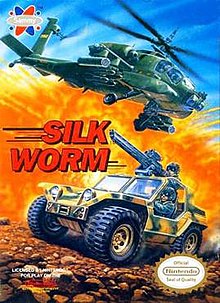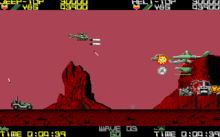Silkworm (video game)
| Silkworm | |
|---|---|
 Cover art (NES) | |
| Developer(s) | Tecmo |
| Publisher(s) | Tecmo The Sales Curve Sammy Virgin Mastertronic |
| Composer(s) | Barry Leitch (Amiga) |
| Platform(s) | Arcade, Amiga, Amstrad CPC, Atari ST, Commodore 64, Nintendo Entertainment System, ZX Spectrum |
| Release | 1988 |
| Genre(s) | Scrolling shooter |
| Mode(s) | Single-player, Two-player |
Silkworm is a horizontally scrolling shooter video game developed by Tecmo and first released for arcades in 1988. In 1989, it was ported to the Amiga, Atari ST, Commodore 64, ZX Spectrum, Amstrad CPC systems by The Sales Curve and released by Virgin Mastertronic in 1990. Sammy released a version for the Nintendo Entertainment System.
Silkworm inspired the 1991 game SWIV and even though it was not a direct sequel, it followed the same core gameplay design of a helicopter/jeep team, albeit as a vertically scrolling shooter instead of a horizontally scrolling one and was described as "inspired by" and a spiritual successor by several reviews, both of the time and contemporary, respectively.
Release
[edit]Silkworm was released at a time where side-scrolling shooters were among the most popular genres. It was released at the same time as Forgotten Worlds,[1] Sanxion,[2] Mr. Heli[3] and DNA Warrior.[4]
The Spectrum version took three months to develop and was converted from the Amiga version which was almost identical to the original.[5] The game reached number three in the UK Spectrum sales charts, behind RoboCop and Dragon Ninja.[6]
In November 1990, Virgin re-released Silkworm as part of the Edition 1 compilation, which also included Double Dragon, and the shoot'em ups Gemini Wing, and Xenon.[7]
Gameplay
[edit]
The player can take control of a jeep mounted with a machine gun or a helicopter mounted with forward and downward firing guns. Two players can work simultaneously and cooperatively against enemies, with one playing as the jeep and the other as the helicopter.
Silkworm featured a variety of enemies, some of which had specific weaknesses, such as the armoured AA guns that could only be harmed when their shields were down. Enemies included the "Goose" helicopter which was a gigantic, heavily armoured "mini-boss" helicopter composed of several smaller vehicles connected together.
The players collect shields (which could alternatively be shot by the player in order to destroy all enemies on the screen), power cells that increase firepower and an additional bonus can be added to the score achieved. The game gets harder after the completion of each level, which feature destructible environmental elements, such as buildings and ancient ruins.
The speed was one of the defining parts of the gameplay, which the programmers who worked on the home conversions were keen to preserve, using a variety of programming techniques.[5] Silkworm featured a background music theme composed by Barry Leitch, which went on to be included on a Sinclair User covermounted cassette, along with Shinobi and Continental Circus.[8]
Ending
[edit]As an arcade game, Silkworm has no ending, but the home conversions were altered to have either a victory screen, or a more involved final sequence.[9][10] The end text reads:
AND HISTORY RECORDS THAT DURING THESE 11 DAYS MANY LIVES WERE LOST. PEACE RETURNED TO THE NOW DECIMATED COUNTRYSIDE. THE PEOPLE RETURNED TO FIND CROPS RUINED, CHURCHES DEFILED AND THE VILLAGE POND DRIED UP. A MEETING OF THE ELDER'S PLEASANT PEASANTS IN THE LOCAL PUB DISCOVERED THAT THE PEOPLE SAW THE FUNNY SIDE OF IT.
Reception
[edit]| Publication | Score |
|---|---|
| Crash | 73%[13] |
| Computer and Video Games | 87%[15] |
| Sinclair User | 86%[14] |
| Your Sinclair | 90%[12] |
| The Games Machine | 77%[16] |
| Publication | Award |
|---|---|
| Your Sinclair | Megagame |
| Sinclair User | SU Classic |
In Japan, Game Machine listed Silkworm on their April 1, 1988 issue as being the fifth most popular table arcade unit at the time.[17]
The game was well received. Your Sinclair praised the 2-player mode and the sound effects.
Legacy
[edit]The 1991 game SWIV was considered a spiritual successor to Silkworm, which The Sales Curve had previously converted to home computer formats in 1989. The game's heritage is evident from the game design whereby one player pilots a helicopter, and the other an armoured Jeep. SWIV is not an official sequel, as noted by ex-Sales Curve producer Dan Marchant: "SWIV wasn't really a sequel to Silkworm, but it was certainly inspired by it and several other shoot-'em-ups that we had played and loved."[18][19][20]
SWIV was described in the game's manual as meaning both "Special Weapons Intercept Vehicles" and "Silkworm IV".[21]
References
[edit]- ^ "The YS Rock'n'Roll Years - Issue 43". Ysrnry.co.uk. Archived from the original on January 22, 2012. Retrieved January 22, 2012.
- ^ "The YS Rock'n'Roll Years - Issue 42". Ysrnry.co.uk. Archived from the original on January 25, 2012. Retrieved January 22, 2012.
- ^ "The YS Rock'n'Roll Years - Issue 44". Ysrnry.co.uk. Archived from the original on January 25, 2012. Retrieved January 22, 2012.
- ^ "The YS Rock'n'Roll Years - Issue 41". Ysrnry.co.uk. Archived from the original on May 28, 2016. Retrieved January 22, 2012.
- ^ a b "Sinclair User". www.worldofspectrum.org. Retrieved December 29, 2024.
- ^ "The YS Rock'n'Roll Years - Issue 46". Ysrnry.co.uk. Archived from the original on January 25, 2012. Retrieved January 22, 2012.
- ^ "Edition 1". Ysrnry.co.uk. Archived from the original on January 24, 2012. Retrieved January 22, 2012.
- ^ "World of Spectrum - Sinclair User issue 92: 6 Amazing Coin-Op Tracks".
- ^ Silkworm (Amiga 50Hz) - All Clear / No Miss (Heli) - 1,229,600 points. YouTube. Archived from the original on December 11, 2021.
- ^ ChinnyVision - Ep 297 - Silkworm - C64, Spectrum, Amstrad CPC, Atari ST, Amiga, August 29, 2019, archived from the original on December 13, 2021, retrieved August 30, 2019
- ^ South, Phil (November 1989). "YS Tipshop". Your Sinclair 47. Dennis Publishing. Retrieved August 26, 2023.
- ^ "Silkworm". Ysrnry.co.uk. Archived from the original on December 2, 2000. Retrieved January 21, 2012.
- ^ "Archive - Magazine viewer". World of Spectrum. Retrieved January 21, 2012.
- ^ "Archive - Magazine viewer". World of Spectrum. Retrieved January 21, 2012.
- ^ "Archive - Magazine viewer". World of Spectrum. Retrieved January 21, 2012.
- ^ "Archive - Magazine viewer". World of Spectrum. Retrieved January 21, 2012.
- ^ "Game Machine's Best Hit Games 25 - テーブル型TVゲーム機 (Table Videos)". Game Machine (in Japanese). No. 329. Amusement Press, Inc. April 1, 1988. p. 25.
- ^ Bevan, Mike (2008). "The Making of SWIV", Retro Gamer (58): 40-43.
- ^ Mason, Graeme (July 30, 2023). "The story of SWIV". Eurogamer.net. Retrieved September 9, 2023.
- ^ Caswell, Mark (April 1991). "SWIV review". Crash. Newsfield. Retrieved September 9, 2023.
- ^ "ACE - Issue 40". ACE. January 1991. Retrieved September 9, 2023.
External links
[edit]- 1988 video games
- Amiga games
- Amstrad CPC games
- Arcade video games
- Atari ST games
- Commodore 64 games
- Helicopter video games
- Horizontally scrolling shooters
- Multiplayer and single-player video games
- Nintendo Entertainment System games
- SCi Games games
- Video games developed in Japan
- Video games scored by Barry Leitch
- Virgin Interactive games
- ZX Spectrum games
